Lazarus Did Stink
Saturday, April 03, 2010
 William Scherk sent me an envelope that arrived on Thursday. Little did I know that the fridge magnets inside would connect to the weekend events. The plans for the weekend included a family Easter dinner Saturday night and an afternoon (on Sunday) merienda (the Spanish version of tea, usually had at 6 P.M. and with thick hot chocolate instead of tea. The plan began to unravel on Thursday afternoon when our weekly cleaning lady (a sweet and gentle woman originally from Central America) arrived with a bit too much to drink. Within the hour she began to sing and cry and she was all muddled up about what to do next. Then to my horror I spotted an almost empty bottle of Austrian Schloss Kirsch in my den. I keep it there with an unopened bottle of Gilbey’s Dry Gin (autographed for me by Lord Gilbey) and an opened bottle of Argentine Torrontés white wine. The wine is for cooking and the 40% alcohol bottle of kirsch is for my frequent cheese fondues. By the time Rosemary showed up our housekeeper was swinging between falling down and showing us a scary propensity towards violence. Rosemary put on her tennis shoes and I called a cab. The cab took her home. Friday we went shopping for the food we were going to use for our Saturday night Easter Dinner. By three when we got home we spotted a fire truck on our lane. A line was down because of the severe windstorm. We were not to know then but our power did not come back until Sunday at four in the morning. We quickly found out or remembered that the furnace would not work as both the thermostat and the electric motor that pumps the air up through the registers are electric. We soon found out that since we didn’t; have a small Coleman stove we could not even heat water for tea or coffee. We read our papers and out books with candles. All our flashlights were dead because Lauren (a nasty habit of hers) had left them all on weeks ago. We survived Friday night with a warmish (water from the hot water heater) hot water bottle in bed. Breakfast consisted of sliced mangoes and juice. Easter dinner was postponed to Sunday and today Saturday evening we took food to Hilary’s where I cooked Mexican pasta soup and quesadillas. Rebecca had baked a delicious white cake in honor of Rosemary's birthday which we decided to celebrate as Easter (since our eldest daughter Ale was present) instead of her real birthday on April 19. We got home Saturday night expecting to find the hydro trucks. They were not there. We settled, depressed, into bed but were awakened by the sound of chain saws at midnight. By four we had lights. As I looked at Schirk’s fridge magnets I thought again at how I have always equated a fridge to the human body. Everything is fine as long as the fridge has power. As soon as the power is out, the food inside begins to spoil and the smell appears. When this happens I always remember what Brother Edwin taught us back at our religion class at St. Ed’s High School. Easter is as much the festivity of Christ rising from the dead as well as the raising of Lazarus by Christ as re-told by St. John in in John 11. There is a passage that will always be in my memory. It was a cave with a stone laid across it. “Take away the stone, Jesus directed. Martha, the dead man’s sister, said to him, “Lord it has been four days now; surely there will be a stench!”The New American Bible, 1973 by Catholic Press.  But as events unfolded I found reasons to feel happy. As I was finishing Andrew Greeley’s book on Saturday night, The Archbishop in Andalusia – a Blackie Ryan Novel, I smiled when I read the dialogue between Archbishop John Blackwood Ryan and Cardinal Diego Sanchez y Romanos, El Moro, Archbishop of Seville: Archbishop Blackie: …I told her that she had come back from the dead. I said that resurrections meant new beginnings, that God expected a new beginning from her. A new life which was a renewed life. She was still shaking with fear…and all the time desperately holding the hand of the husband of whom she was afraid.”Archbishop Diego Sanchez y Romanos: “Resurrections are not supposed to be easy.”Archbishop Blackie: “Even for Jesus?”Archbishop Diego Sanchez y Romanos: “I have never been in a position to ask him. But for the rest of us new beginnings mean new terrors.”In many ways Saturday, called Sábado de Gloria in Spanish seemed a bit like that as we adapted to new situations that had been unexpected but cleverly predicted by old Rádico Popularos', William (Bill) Scherk when he sent me the fridge magnets.
Donald McLaren Goes To War
Friday, April 02, 2010

John Gray and Eric Peterson’s Billy Bishop Goes to War premiered at the Vancouver East Cultural Centre in 1978. I did not attend that performance of this Canadian play that has become an icon about Canada’s transformation from being a colonial dominion of the British Empire to a full-fledged country through its heroic involvement in WWI. My first performance was a remounting of the play at the Playhouse Theatre in August, 1982. And I saw it again on Wednesday night.
1978 was an important date for me professionally as in August I had my first Vancouver Magazine cover. It was a feature written by Valerie Gibson about 7 British Columbians in their 80s who had achieved lofty stuff. Two in particular are in my memory. One was the delightful Jessie Richardson and the other was an 85 year-old man who had a connection to Billy Bishop.
Reflecting
By Valerie Gibson
Vancouver Magazine, August 1978
“Don’t you try to make a hero out of me,” said Donald McLaren. “I’ve lived longer, that’s all.” And done a little more, too. Like becoming one of the four top Canadian flying aces of World War I. “These things are accidental, you know – whether you get a chance to shoot down enemies or not. Men like Billy Bishop and I came along when there was plenty of opportunity.”
Grounded with a broken leg (wrestling match with a junior officer) for the last month of that conflict, McLaren in the previous eight months had downed 48 aircraft, destroyed six balloons and rose to command the 46th Squadron. He came back to Canada with the DSO, Military Cross and Bar, a DFC and no desire at all to talk about it. “Too many lives…But some fun times, too."
“I well remember one of the first patrols I went on in France. I was a second lieutenant – nobody in those days –in the winter of 1917, and my flight commander and I were just flying on the outside and I thought, ‘Well, there’s the enemy.’ You could see them over you, you know, and I wondered, ‘Are we going to have a fight with these guys?’ I tried to remember everything I’d been taught, and I remember saying a prayer about it and…well, we’re here now, make the best of it. The patrol came by us no more than a hundred yards away. There were five of those fellows, painted very color of the rainbow, and they paid no attention to us. Just singing’ right on by, sunshine on them…beautiful sight.
“But my flight commander didn’t make a move. We might just as well have kissed each other. They used to call that the Peacetime of November. We’d meet them on the front. They wouldn’t shoot at us; we wouldn’t shoot at them. After the March Push began, it was different altogether. Remember Von Richtofen? You couldn’t go near him. They’d be after you, you’d be after them.”
For someone with no early compulsion to fly (he signed up to get to see a sweetheart in the east), aircraft became an important factor in the life of Donald Roderick McLaren. When the Canadian government, interested in the potential of the new-fangled machines, decided to set up a branch for fisheries patrols, aerial mapping and for training civilians, McLaren was called to Vancouver to choose an air base location. He picked Jericho. That was 1919. In 1924 he bought a second hand HS2L flying boat, then a “Jenny”, and started freight and passenger service between Vancouver, Victoria, Seattle and upcoast settlements. In the lean times of 1928, his company, Pacific Airways, was taken over by Winnipeg financier James Richardson’s Western Canada Airways LTD. McLaren stayed on in charge of Pacific Lines when the assets of WCA and an eastern company, Aviation Corporation of Canada, were combined to form Canadian Airways Limited, making it the largest of the country’s air companies.
Air travel was moving out of the bush leagues by then. They were flying a ten-passenger Sikorsky and buying Fokker Supers and Fairchilds when C.D. Howe, then Minister of Transport, asked McLaren to help in the formation of TCA. That was 1937, and five days later the Trans Canada Airlines Act was proclaimed, one D.R. McLaren being employee number one.
After a long an eminent career (he is a member of the Canadian Aviation Hall of Fame), McLaren retired 20 years ago at 65. Today, he is a reflective, religious man active in the Bahia faith. “If you believe in it, you’re active in it. Oh, I’d like to fly again but I won’t.”
“I never wanted to do something like Charles Lindbergh did. I felt very happy about the fact that we were providing a service where it was needed, and we weren’t just playing in a game. Some of it was dangerous and some of it wasn’t. When you are sitting at six –thousand feet near Mount Waddington, looking at that beautiful scenery, there isn’t anything more beautiful…and you’re part of it. “
Billy Bishop 74 kills.
Raymond Colishaw 60 kills
Donald Roderick McLaren 54 kills, Donald Roderick McLaren died on July 4, 1989 when he was 96.
Billy Bishop's Nieuport 17 - A Chair, A Broom & A Ladder
Thursday, April 01, 2010
 Going to see a play that one has not seen in 28 years is like trying to relive or remember a dream over the toilet during a middle of the night call. The memories seem to fade almost immediately. But this time around my memories have a tactile element (negatives and transparencies) and a visual one. The particular folder in my extensive files says Billy Bishop. Inside I find an envelope that says August 1982, Playhouse Theatre. So I know I never saw the original production at the Vancouver East Cultural Centre in 1978. I have no idea who commissioned me to take these pictures of an obvious re-mounting at the Playhouse with a nice big set and what looks like an almost real airplane. My wife Rosemary says she sat at the last row at the Playhouse while I was in the lighting booth. It seems I must have been discussing with the lighting person what kind of light I would need to serve as a level for my own flash umbrellas. Looking at the pictures memories came back. I remember hearing versions of Billy Bishop performed at one of Vancouver Children’s Festivals and I can remember the sound of John Gray’s piano wafting outside the tents of Vanier Park. Through the years I have become a friend of John Gray as I have taken his picture a few times and I see in his piano playing and in his voice a warmth that satisfies and settles my stress. Gray is like a friendly tom cat. In his presence the world is just fine.  I did see a bit of that in last night’s performance of Billy Bishop Goes to War (an Arts club Theatre Company and Persephone Theatre co-production) at the Granville Island Stage. John Gray’s son, Zachary Gray, brought a quiet (John Gray’s pairing with Eric Peterson seemed to be more in your face) presence with his beautiful smile and his laid back singing while accompanying himself on the piano or guitar (both an acoustic and electric). With his hair combed back with greasy kid stuff he looked like one of those English actors in Masterpiece Theatre productions. My guess is that I will enjoy his performance even more in four years when he is a bit older.  My expectation of the show and the real reason I went to Billy Bishop was to see how my favourite would-be standup comedian would deal with the complex character of Billy Bishop plus all the others he must impersonate. Ryan Beil, below, left, did not disappoint me. Ryan Beil has to be Vancouver’s male equivalent to Lois Anderson who can play serious or funny just like that. In comparing Beil's take on Billy Bishop with what I can remember of Eric Peterson I would say that latter's was conventional in expressing more respect for the role of a fighter pilot in a war of horrors while Beil's wsa more irreverent, more authenting ir refecting the mind of the under 20 Billy Bishop. In my own country of birth, Argentina (and I believe with many US Tea Party members) the stepping by Beil on a British flag is an irreverence that would not be tolerated.  In just the first few moments all of those haunting and catchy melodies came back and I was settled in for a fine night with my Rosemary (she likes little and not often) who somehow had a smile in her face for most of the evening. As per usual Itai Erdal’s lighting (below holding a Christmas ornament) like Sarah Rodgers’(seen here with actor Allan Morgan) direction is almost unnoticeable but there. For me the real fun was Kevin McAllister’s set design. Without revealing more I will just say that the broom-chair-and-ladder airplane and its assembly by Gray and Beil was one of those magically funny moments of the play.  Just about every time that I have been to a play at the Granville Island Stage I have had a bit of a problem hearing all the dialogue from the middle of the middle where we were. In my family I am noted for having an extremely sensitive ear. I am sure that the folks at the Arts Club may have studied this problem and my only amateur suggestion would be to find out if the sound would improve if the piano were to be moved 5 feet forward. But then this is only a minor quibble on part.  For reasons that escape me I have in those Billy Bishop files one envelope that says Billy Bishop at the CBC, Studio 1. Could they, John Gray and Eric Peterson have been recording the play for a radio program?  I am glad that costume advisor Darryl Milot did not suggest a heavier mustache for Ryan Beil. From where I was (I was not ever sure if he did have one) I can see in Beil's future the perfect part made just for him. He will someday play Adolf Hitler. I cannot wait!
Guns, Guns & Guns
Wednesday, March 31, 2010
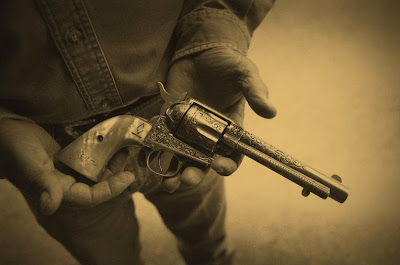 In my trip to Austin, Texas last June to a high school reunion (all classes from 1872 to 1967, and few if any showed up from the classes of the 19th Century) I quickly realized that my classmates were not the ones I had shared a dormitory, room and classroom and playing fields for four years. I quickly understood I could not bring up the subject of Obama, the Canadian health system and gun control. My former classmates all either carried concealed handguns (at the very least they had them in their cars) and many thought it was their God-given right to carry an unconcealed one. They wanted to go back to the time of Wyatt Earp in Tombstone and Dodge City. I was shocked and never more so when traveling with my schoolmate John Arnold to visit our friend Michael East in his ranch in South Texas. Between John Arnold (a former member of the US Marine Corps) us under the arm rest of his F-15 Twin Cab I could discern the grip of his .45 caliber semi-automatic equipped with laser sites. 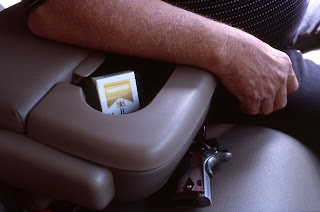 My attraction and subsequent feeling of a paradoxical tug of war between an obsession to own a gun and then be repelled by the very idea, began in 1949 when my mother gave me an official Gen Autrey cap gun, complete with holster and Western shirt. I was the king of Melián Street in Buenos Aires as none of my friends had access to American goods. My mother had friends at the US Embassy. It was around 1959 that my mother and grandmother moved to an apartment on Avenida Insurgentes Sur in Mexico City. Below us was an armería (gun store) owned by our retired Basque pelotari (Jai-alai player) Daniel Guridi. I would often visit his shop so I could look at his collection of Breda shotguns but my real interest lay in the Beretta pistols he had. Once, as far as I can remember I was able to get enough nerve and I asked Guridi if he would allow me to hold one. For weeks and months I nagged my mother that I wanted a gun. She finally relented and Guridi gave me an extremely realistic .22 revolver that could only handle blank cartridges. In the Argentine Navy I quickly passed all the tests for shooting the Mauser rifle, the US issue grease gun and the Llama .45 semi automatic. 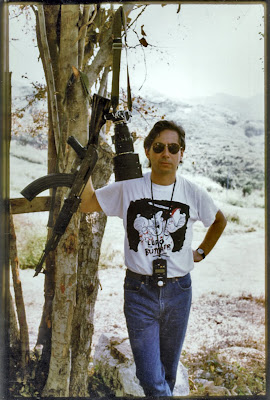 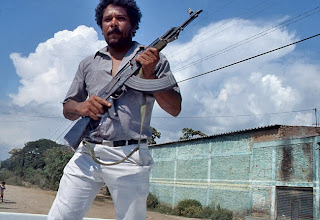 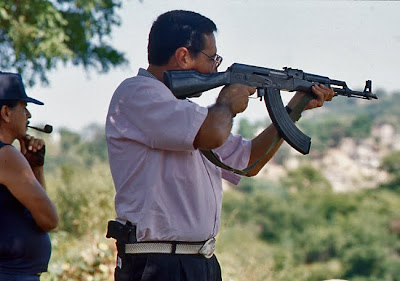 Around 1973 I had a student (see, below, left) in Mexico who was in my English class at Colgate Palmolive. He told me (since he was blonde) that he was a descendant of Pancho Villa and an Irish/American woman he had wooed. I now forget the name of the pleasant man who had a sweet and steady personality. He told me that he was so because he went target shooting every weekend. He invited me a couple of times. I must say that the noise and kick of a Colt 0.45 semi automatic pistol is one of those noises that I place with others that are my favourite like that of the de Havilland Beaver’s radial Pratt & Whitney engine. And I must also admit that I would go home feeling relaxed after those sessions at the gun range. 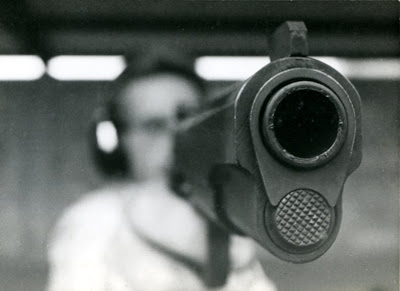 But I never after that ever wanted to own a gun. I think I have a quick temper and I would never want a gun in the house. Around 1990 in my early years of gardening I was furious that squirrels would munch on our garden bulbs. I went to The Three Vets and purchased a replica of the .357 Magnum (complete with long and short barrels). It was an air gun that fired BBs. I meant to shoot the squirrels. I decided I was going to give them a sporting chance so I would not wear my glasses. I would suddenly open the kitchen door (overlooking the garden) and the squirrels would scurry away. Just once I hit one mid air and it plummeted to the ground. It was not quite dead so I had to shoot it in close quarters. This was tough. When my daughter Hilary found out she told me she was going to report me to the S.P.C.A. if I shot and killed one more squirrel. It all became moot as weeks later a burglar walked into our house in the middle of the night (at the time I did not lock the front door) and the thief went away with my word processor, my CDs and my stereo. It took me some days to find out that he had also taken the gun. I never claimed the gun with the insurance and left it at that. I would never ever want to own any kind of gun. In 1996 I received call from a young man called T’ai Erasmus. He wanted me to photograph him with his Olympic air rifle (he competed for Canada as an Olympic Target Shooter for 16 years). The man who faced me in the studio had complete confidence. He told me he was going to become an Olympic champion. I am not sure he ever did but he did go to become a prominent and well known fitness instructor. What especially impressed me about this confident young man was the equanimity he projected when he posed with his rifle. 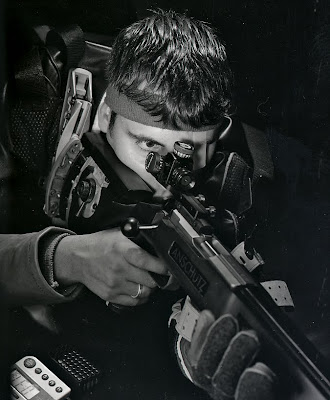 When I spotted some vicious looking knives framed on the wall of John Arnold’s home in Austin I realized that my rough and ready friend, who had perhaps killed while in Viet Nam (he also saved many a downed pilot by climbing down ropes from overhead hovering helicopters to pick them up), had the same confidence, equanimity and serenity of T’Ai Erasmus. 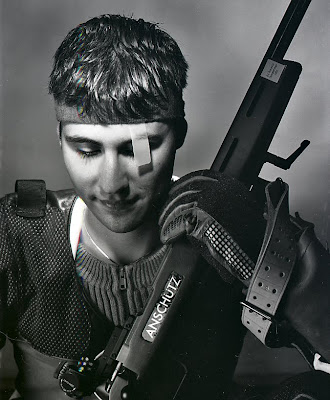 When Arnold and I visited Mike East at his ranch we saw guns displayed on the walls. I was told to watch out for rattlesnakes and not to put my hands into anything in the bush without first looking first. I had not doubt that East carried a gun in the glove compartment of his truck. I asked East to hold his father’s gun for me. He reverently picked it up. I watched his face and I saw that serenity. I will never need it because I will never own a gun.
Lively, Bony & Cleverly & My Snooty Tastes
Tuesday, March 30, 2010
 My mother liked to use the word snooty to describe her taste for things. She preferred that word to the more usual refined. She would often say to me in Spanish, “ Hay poca gente fina como nosotros,” or “There are few people with good taste such as us.” When I was in my late teens she never said anything about my near obsession in reading any science fiction book I could find. As long as I was reading that was fine. But she would hand me books, every once in a while and tell me it was a good book. I learned to trust her taste and I have maintained my snooty taste for books since. I no longer read science fiction but I still (with no apology) read mysteries. For many years the only female mystery author I read was P.D. James. I had a dislike for the likes of Mary Stewart and such books as her gothic/governess novel Nine Coaches Waiting which I remember buying for my mother. She loved it. It is only at this recent date that I have abandoned this silly idea and I have read all the books published until now by Barbara Cleverly. I joke around in telling that this real name sounds as manufactured as that other English author’s name, Penelope Lively!  And it is Penelope Lively which brings me to cite my reading relationship with Celia Duthie. It is Duthie who first recommended Lively to me. Duthie, much like my mother would have been impressed by Lively’s birth in Cairo. For many years back when Duthies was the bookstore empire in Vancouver I would go in to the main store on Robson to ask for my favourite mystery writer Jerome Charyn's latest. Every employee there and Duthie would ask me, “Have you read Michael Dibdin?” I finally broke down and bought my first Aurelio Zen mystery by Dibdin called Cabal and I was hooked. I first read ever book written by the man until that time and then waited every year for his next (and Robert Harris’, and John Le Carré, also authors Duthie liked). It was last year that I read Dibdin’s End Games which was his last as he died. There is nothing sadder that knowing that one’s taste for an author’s works can no longer be satisfied.  But there is another opposite side to that story. This is the discovery of authors who have written (they are usually prolific) a string of novels and one can indulge for some time. Sometimes I find them halfway so after reading their output I have to then wait for the next. That has been the case with Colin Dexter (alas he is now dead), Reginald Hill (he isn’t!), and Patrick O’Brian (he is!). And of course I am waiting for Barbara Cleverly’s next Inspector Joe Sandilands mystery and her next Laetitia Talbott one. Then there are authors like Andrea Camilleri and his Inspector Montalbano series. I have read all the ones that have been translated into English including the latest The Wings of the Sphinx. The author, who is in his 80s, is still writing them, but I must wait for the translations as they occur.  One happy situation came my way some years ago when Duthie gave me a used copy of Arthur W. Upfield’s Venom House featuring his half breed inspector Napoleon Bonaparte (“Please call me Boney!”). I was hooked from the first. The writer and Englishman who had been sent to Australia as a young man by his father and died in 1964 had written 29 of them. It was up to me to find the other 28. Since Upfield has long been out of print this took some effort and I got as far as number 25. Each one of these can be read independently out of order and they all describe a way of life in the remote stations of Australia that has all but faded with modernity and globalization. I do think that about now I might attempt to tackle Upfield all over again. I have been struggling (but with pleasure!) with Harold Bloom’s Where Shall Wisdom Be Found? At this moment I am finding out why it was that Plato was so much against poets and in particular with Homer. But the real gem of this book has been to find out that the Book of Job is well worth reading in detail.  Upfield might have to wait as I have “discovered” Father Andrew M. Greeley. But that is another story for another day. Arthur W. Upfield
Wonderland
Monday, March 29, 2010
 |
| Alex at St. Ed's, Austin, Texas 1960 |
In a not so distant spring I remember being able to fall asleep listening to the splash of the pond fountain outside my window and wake up to singing birds in the morning. Six to 8 yours of sleep were compressed between the pleasures of slumbering into sleep and the awaking awareness that I was alive the next morning. Not so, anymore.
Aging bodies react differently to being in a horizontal position and pressures are brought to bear. I wake up three or four times during the night and I must visit the gentleman's room only to find out that the pressures were premature. But there are pleasures to be had here.
Nobody will ever convince me that death and sleep are the same. I will go as far as accepting Epicurus’ views that there is no feeling in death. And if there is no feeling there is no pain. If there is no pain there is nothing to fear. But not being able to wake up again (death), while not painful brings no pleasure.
The pleasure of sleep is threefold. Falling asleep can be wonderful. Waking up can be pleasant, too if one is not facing a stressful day. It is that in-between period, between sleep and wakefulness that seems to be the most interesting.
That in-between period involves dreaming. This idea was reinforced in my mind today by my taking my granddaughters to see Alice in Wonderland (the 3-D version). I dream almost every day and I can assert that I probably dream every day and that I am not aware sometimes because the dream slips away into some subconscious, a place populated by single socks and the source of clouds that marr empty and clear blue skies.
I will not go to Greenelandian extremes. Graham Greene for most of his life had a pad and pencil on his bedside table. He made it a habit to record his dreams. For me it is enough that I have post-it notes for marking good pages in the books I read and a Canadian Oxford Dictionary for reference.
The new evening bathroom arrangements give me the pleasure of being able to think, “I am awake. I was happily asleep and as soon as I finish I will go back to bed and sleep again. Should I wake up, one more time, the pleasure will be repeated.
At one time I suffered from severe bouts of insomnia. Those are gone as well as those migraines that haunted my waking days. I have never taken snuff. I understand that sneezing is as much of a pleasure as scratching an itch. I can assert that being able to fall asleep without a problem, knowing that I have a pretty good chance of waking up, is pleasant. I don’t miss the long oblivion of my nights of youth.
The current situation means that my dreams are now of two varieties. I have short dreams (fully complete but brief) or I have dreams that continue between periods of wakeful rest.
It is standing over the toilet that I attempt to write in my mind that dream before it fades. Greene was right.
My dreams are either bizarre (these are the ones I rarely remember) or they are fantastically realistic to the point that when I wake up I sometimes feel like that poor man in the hospital (in that Julio Cortázar story, La Noche Boca Arriba, The Night Face Up) who is getting over a motorbike accident. He has constant dreams of being taken up to the top of a pyramid to have his heart torn out by an Aztec priest. He always manages to wake up just before. But not the last time when he realizes that the motorbike and the hospital are the dream and the tearing out of his heart is the frightening and imminent reality.
One of those realistic dreams is the one where I often fly in a pool of air. I gently wave my arms and I am able to stay in place without sinking. I tell myself, “I fly.” Another dream has me playing solo alto saxophone to a large audience. At best I was an efficient player in my high school band. But here I wow them and the dream is so real that I am almost sure that I did play once, without reading a note. That day has faded and all that remains is the dream as proof that it might have happened. It is a sort of Alice in Wonderland.
But the one dream that has persisted for years is the one where I return to my St. Ed’s High School in Austin, Texas as either an older boy or a mature man. I explain to the undergraduates (I am usually there with an assorted variety of my former classmates) that my education and experience were so good that I have decided to extend it by returning to school.
Sometimes in this dream I knock on the door of the inner sanctum where our teachers, Brothers of the Holy Cross, lived. It was verboten to enter. But in my dream I am allowed in and I am greeted with warmth.
Part of this dream did become real last year in June. I returned to my school for an all classes reunion (1920-1967). When I arrived at the Austin airport and was met by my classmate John Arnold I was told that we and his wife were invited for dinner that evening with Brother Edwin at the inner sanctum of St Joseph’s hall. As Brother Edwin said grace and we were surrounded by the elderly faces of the other Brothers of the Holy Cross, I wanted to pinch myself just like Alice to see if I was in my dream.
Two Seriously Funny Fellows
Sunday, March 28, 2010

My first impression of art as a serious medium began sometime in 1955 when I visited for the first time the Castillo de Chapultepec, a museum/castle on a lofty perch of Chapultepec Park in Mexico City. It was there that I first saw the works of Mexican muralist Jose Clemente Orozco (seen below, is his Resurrection of Lazarus, 1942). My mother told me how she tried not to look at them as they unsettled her. Of course this made me look at them all the more. It was through Orozco that I found out that art did not necessarily have to be pleasant and beautiful and that it could contain a message for change especially within corrupt systems.
This idea had not clicked with finality in my head until 1999 when I went to see Carlos Saura’s film Goya In Bordeaux with my Argentine painter friends Nora Patrich and Juan Manuel Sanchez. The film was so good we saw it twice before the folks of our city found the movie much too complicated and it vanished in a week from showings at the Fifth Avenue Cinemas.
In my classes at Focal Point and at Van Arts when I teach editorial photography I point out that the Goya was one of the first artists to use his art to protest the tyranny of the conservative and corrupt Spanish monarchy, not to mention his fight against the total war that Napoleon Bonaparte had unleashed upon Europe.
It is only now that I can understand within me that without Goya, the careers of Mexican muralists Orozco, David Álvaro Siqueiros and Diego Rivera would have never happened. It is difficult not to see Goya’s influence in Edouard Manet’s painting the Execution of Maximilian where one of the soldiers is a facsimile of France’s Napoleon III. Manet put the blame for the execution of Maximilian, and the abandonment of the attempt of a French empire in Mexico, squarely on the shoulders of Napoleon III himself.

Just as I now know about the seriousness of purpose of many artists I have also come to understand that art can also entertain, delight and even make us laugh. I am not an art historian so I cannot here reveal artists who are the equivalent to the unabashedly irreverent poems of Ogden Nash. It would seem to me that anybody would “get” that Salvador Dalí was not all that serious. In short I have come to understand that many artists have a tongue in check humor that they keep almost hidden and usually it is not to be discovered by the art critic. Art, in the minds of these art critics has to be serious. So they interview artists with reverence and write about their works without the slightest hint of fun or humor.
It was sometime in the middle 90s that artist Rodney Graham (he had a studio on the same floor as I did on Robson and Granville along with fellow artist Neil Wedman) knocked on my door. “Alex, I have a problem. I have been taking photographs of trees with a 4x5 inch camera and the images in the back of the camera are all upside down. What can I do about it?” I told him that he would have to spend lots of money to get a device that would right side up the image. I told them that most photographers had come to learn to take their pictures with the images pointing down.
It was in May 1997 that I was assigned by the Globe & Mail to photograph Graham. I was told that the writer would be Sarah Milroy. I contacted her and we met. She told me she was going to pursue the subject of “Postmodern Art as Seen through Rodney Graham’s Upside Down Trees”. I almost choked! Subsequent to my conversation with Graham at my studio Graham had shown high quality and large photographs of trees that were matted and framed upside down. You can purchase these at the Vancouver Art Gallery shop.
I decided to photograph Graham as an angry artist of the European 30s. I was going to make him look scary. This I did. Fortunately Milroy had caught on and had seen through Graham’s serious front and discovered his subtle and gentle humor. The Globe article, Saturday, June 7, 1997, ran my picture with the following and “all revealing” cutline: Vancouver’s Rodney Graham, a very serious goofball.

Since 1997 I have been on the lookout for the seriousness that our local artists seem to project and how critics read it and write about it.
Last week I had the pleasant opportunity to photograph Lawrence Paul Yuxweluptun at the scene of his present show at the Contemporary Art Gallery. He showed up wearing a black hat, a brown leather jacket and dark wrap-around sunglasses. I didn’t have to ask him to know he would have refused to take the glasses and the hat off or even smile at my camera.
I broke the ice by telling him that I was intrigued by his little drawing under a centrally located glass cabinet of a wood screw and the word USUFRUCT. I told him that in Spanish this was a word that dry cleaners used when you did not pick up your item to be cleaned until months later. Through usufracción the cleaners could sell off or throw away your possession as they had the rights. Yuxweluptun smiled and told me that the word as he saw it was a legal term used in land claims and it plainly showed how people who owned lands, many times, had others who did not own the land profit from it. I did not have to pursue the image of the screw to know what Yuxweluptun had in mind and why he seriously told me, “This is the most serious item in this show.”
We ended talking about trees for a long time and we compared notes on how photographers photograph trees and how curiously I have discovered that trees have to be photographed in their entirety. They cannot be cropped. The same applies to the human face were you can rarely get away with topping a person’s head. Yuxweluptun showed me a drawing that was a close cropped view of the lower trunks of a group of trees. We saw this as an allowable exception.
During our portrait session my 10 pictures all looked the same as his expression was the same. In one I made a joke and he began to laugh. I took the picture. “You know, if I send this one to the Georgia Straight they will use it.” He looked at me and gently told me, “Don’t send it.” I didn’t but you can see it here.

Going back to Goya I have discerned lots of humor in his etchings Los Caprichos, particularly one sporting a fully dressed donkey and called “And So Was His Grandfather”
Now if we could only make our critics smile, just a bit.
Another artist with a sense humor Michael Nicoll Yahgulanaas
And yet another Neil Wedman
|


































